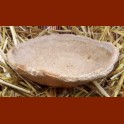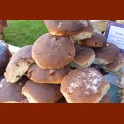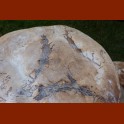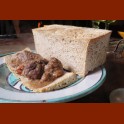Medieval bread 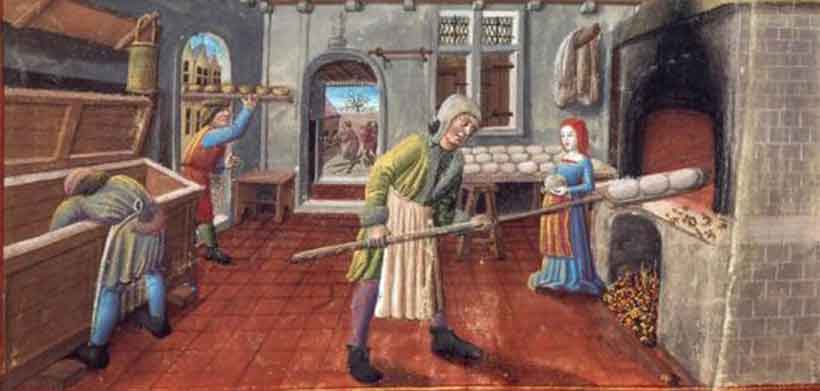
Medieval bread (a medieval recipe)
Bread represents the main part of the medieval diet. There is a culinary term for all dishes accompanied by bread from the 12th century, the companage (from the Latin cum, with and panis, bread).
Generally speaking, the well-to-do people of the towns and countryside love white bread, pure wheat, finely sifted. (...
Medieval bread (a medieval recipe)
Bread represents the main part of the medieval diet. There is a culinary term for all dishes accompanied by bread from the 12th century, the companage (from the Latin cum, with and panis, bread).
Generally speaking, the well-to-do people of the towns and countryside love white bread, pure wheat, finely sifted. (which gives a very white crumb and leads to a loss of half).
The bread of peasants and more modest people is brown or wholemeal, as are the slices on which solid foods are placed during meals (slicers). These breads are of different quality and weight, but they are round and have little or no salt.
Depending on the region, the bread could include several cereals. Half of the cultivated fields were sown with wheat, the other half was divided between barley, oats, rye and millet. "Buckwheat, i.e. buckwheat, only appeared at the end of the Middle Ages and in the west of France,
Bread was kneaded at home by the women in the country and was baked in the collective oven, often the property of the lord. Breads weighing up to 7 kilos could be rare and spaced out (only one or two in some regions).
Around the 14th century, very precise rules were put in place by Charles V in 1366: the talmeliers could only make breads of the same weight, with a single flour, and at the same price. They will make two kinds of bread, one of such weight of 4 deniers, and the other of 2 deniers. In 1439, a fixed price for bread was adopted.
Cereals were also eaten in the form of porridges or cakes, mainly in Eastern Europe. In Northern Europe, from Great Britain to Poland, oatmeal porridges were consumed. The Welsh people eat a kind of oatmeal for soup with leeks, butter, milk and cheese cut into pieces. In Northern Italy, Sorghum Polenta is eaten. The Lombards eat panicum or millet with milk.
More

Medieval bread (a medieval recipe)
Bread represents the main part of the medieval diet. There is a culinary term for all dishes accompanied by bread from the 12th century, the companage (from the Latin cum, with and panis, bread).
Generally speaking, the well-to-do people of the towns and countryside love white bread, pure wheat, finely sifted. (...

Medieval bread (a medieval recipe)
Bread represents the main part of the medieval diet. There is a culinary term for all dishes accompanied by bread from the 12th century, the companage (from the Latin cum, with and panis, bread).
Generally speaking, the well-to-do people of the towns and countryside love white bread, pure wheat, finely sifted. (which gives a very white crumb and leads to a loss of half).
The bread of peasants and more modest people is brown or wholemeal, as are the slices on which solid foods are placed during meals (slicers). These breads are of different quality and weight, but they are round and have little or no salt.
Depending on the region, the bread could include several cereals. Half of the cultivated fields were sown with wheat, the other half was divided between barley, oats, rye and millet. "Buckwheat, i.e. buckwheat, only appeared at the end of the Middle Ages and in the west of France,
Bread was kneaded at home by the women in the country and was baked in the collective oven, often the property of the lord. Breads weighing up to 7 kilos could be rare and spaced out (only one or two in some regions).
Around the 14th century, very precise rules were put in place by Charles V in 1366: the talmeliers could only make breads of the same weight, with a single flour, and at the same price. They will make two kinds of bread, one of such weight of 4 deniers, and the other of 2 deniers. In 1439, a fixed price for bread was adopted.
Cereals were also eaten in the form of porridges or cakes, mainly in Eastern Europe. In Northern Europe, from Great Britain to Poland, oatmeal porridges were consumed. The Welsh people eat a kind of oatmeal for soup with leeks, butter, milk and cheese cut into pieces. In Northern Italy, Sorghum Polenta is eaten. The Lombards eat panicum or millet with milk.
Showing 1 - 4 of 4 items
Assiette en pain
1,90 €Gingerbread
500 g of bread Ginger Bread Brioche with candied ginger and powder , raisins and almonds.
6,00 €Moflet
1 kg - The moflet , also called choine contains a little butter , egg , sugar (very little) and spices ( to flavor slightly).
8,00 €Tranchoir (tranchouers)
3,50 €
Showing 1 - 4 of 4 items

